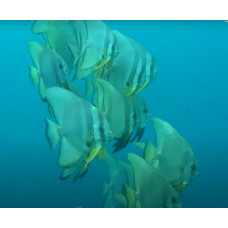Latin name
Platax teira
Other names
Longfin batfish, longfin spadefish, round faced batfish.
Identification
The body is rounded and strongly compressed, its depth more than twice the length of the head and 0.9-1.2 times the average length. The length of the head is 2.7-3.5 times longer in large adults (standard length more than 35 cm), with a bony tubercle from the top of the head to the interorbital region, the anterior profile of the head is almost vertical. The width of the interorbital spaces ranges from 42 to 50% of the length of the head. Jaws with rows of slender, flattened, tricuspid teeth, the central projection slightly longer than the lateral ones. Five pores on each side of the lower jaw. Facial surface smooth. Facial surface without spines.
Features of fish fins
Dorsal spines (total): 5-6; Dorsal soft rays (total): 28-37; Anal spines: 3; anal soft rays: 22-28. In large juveniles, the pelvic fins and anterior soft rays of the dorsal and anal fins are strongly elongated and reach the anterior edge of the anal fin base.
Fish colouring
There is a dark spot below the pectoral fin and another long dark mark above the base of the anal fin. This fish is usually silver, grey or brownish. It has a blackish stripe across the eye and another stripe on the pectoral fin. They are capable of changing colour from silvery white with no stripes to brown with darker stripes and then back to silvery. Very small juveniles are brownish and look like floating leaves.
Distribution
Widespread in the Indo-Pacific from the Red Sea and East Africa to Papua New Guinea, north to the Ryukyu Islands, south to Australia. They have also been found in the Bay of Islands in New Zealand. In Australia, they are found from the central coast of Western Australia, the tropical north of the country and south to the southern coast of New South Wales. In India, they were reported from the Gulf of Mannar after the 2004 Indian Ocean earthquake and tsunami. They have been reported twice recently in the Mediterranean, off the coasts of Turkey and Israel.
Habitat
A marine, reef-dwelling, amphidromous, tropical species. They are known to live among floating algae, rubble and artificial reefs. This species is found in both shallow coastal habitats and deeper waters.
Size
The maximum published total length of this species is 70 cm (28 inches).
Behavior
Juveniles cling to floating debris and form aggregations. As they grow, they become increasingly pelagic, forming large shoals that take refuge in a large mass of sargassum.
Food and feeding habits
Omnivorous. Feeds on plankton, small invertebrates and algae.
Reproduction
There is no sexual dimorphism. Eggs fertilised by swimming are pelagic, as are the larvae, which begin to colour when they are about 5 mm long, when the first black stripe appears, hiding the eyes.
Fishing
Caught by hook and line, traps, spears, trawls and hand nets. Not an important commercial fish.
Relationship with a person
Very peaceful and sociable fish, forming schools with other members of their species in the aquarium.
Edible but not prized.
| Classification | |
| Phylum | Chordata |
| Class | Actinopterygii |
| Squad | Moroniformes |
| Family | Ephippidae |
| Genus | Platax |
| Species | P. teira |
| Features | |
| Conservation status | Least Concern |
| Habitat | Pelagic |
| Life span, years | 20 |
| Maximum body weight, kg | No information |
| Maximum length, cm | 70 |
| Sailing speed, m/s | No information |
| Threat to people | Edible |
| Way of eating | Planktonophage |
Teira batfish
Tags: teira batfish



